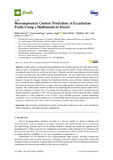Mostrar el registro sencillo del ítem
Biocompounds content prediction in Ecuadorian fruits using a mathematical model
| dc.creator | Llerena Silva, Wilma Maribel | es_ES |
| dc.creator | Samaniego, Iván Rodrigo | es_ES |
| dc.creator | Angós, Ignacio | es_ES |
| dc.creator | Brito, Beatriz | es_ES |
| dc.creator | Ortiz, Bladimir | es_ES |
| dc.creator | Carrillo, Wilman | es_ES |
| dc.date.accessioned | 2024-02-09T15:45:56Z | |
| dc.date.available | 2024-02-09T15:45:56Z | |
| dc.date.issued | 2019 | |
| dc.identifier.citation | Llerena, Wilma, Samaniego, Iván, Angós, Ignacio, Brito, Beatriz, Ortiz, Bladimir, Carrillo, Wilman (2019) Biocompounds Content Prediction in Ecuadorian Fruits Using a Mathematical Model. Foods, 8(8). https://doi.org/10.3390/foods8080284. | en |
| dc.identifier.issn | 2304-8158 | |
| dc.identifier.uri | https://hdl.handle.net/2454/47401 | |
| dc.description.abstract | Anthocyanins, carotenoids and polyphenols are biomolecules that give the characteristic color to fruits. Carotenoids relate to yellow, orange and red colors whereas anthocyanins and polyphenols mainly relate to purple and red colors. Presently, standard determination of antioxidants is carried out using relatively complex methods and techniques. The aim of this study was to develop a mathematical prediction model to relate the internal color parameters of the Amazonic fruits araza (Eugenia stipitata Mc Vaugh), Andean fruit blackberry (Rubus glaucus Benth), Andean blueberry (Vaccinium floribundum Kunth), goldenberry (Physalis peruviana L.), naranjilla (Solanum quitoense Lam.), and tamarillo (Solanum betaceum Cav.) to their respective anthocyanins, carotenoids and polyphenols contents. The mathematical model was effective in predicting the total anthocyanins content (TAC), the total carotenoids content (TCC) and finally the total phenolic content (TPC) of fruits assayed. Andean blueberry presented a TPC with an experimental value of 7254.62 (mg GAE/100 g sample) with respect to a TPC prediction value of 7315.73 (mg GAE/100 g sample). Andean blackberry presented a TAC with an experimental value of 1416.69 (mg chloride cyanidin 3-glucoside/100 g) with respect to a prediction TAC value of 1413 (mg chloride cyanidin 3-glucoside/100 g). | en |
| dc.description.sponsorship | The authors gratefully acknowledge that the successful execution of this research work was achieved thanks to the key funding support of the Project 21005270032 belonging to the Strenghthening Institutional Program of the Ecuadorian National Institute of Agricultural Research (INIAP). | en |
| dc.format.mimetype | application/pdf | en |
| dc.language.iso | eng | en |
| dc.publisher | MDPI | en |
| dc.relation.ispartof | Foods 2019, 8(8), 284 | en |
| dc.rights | © 2019 by the authors. Licensee MDPI, Basel, Switzerland. This article is an open access article distributed under the terms and conditions of the Creative Commons Attribution (CC BY) license. | en |
| dc.rights.uri | http://creativecommons.org/licenses/by/4.0/ | |
| dc.subject | Chemometrics | en |
| dc.subject | Mathematical model | en |
| dc.subject | Metaheuristic techniques | en |
| dc.subject | Color | en |
| dc.subject | Araza | en |
| dc.subject | Blackberry | en |
| dc.subject | Andean blueberry | en |
| dc.subject | Naranjilla | en |
| dc.subject | Tamarillo | en |
| dc.subject | Goldenberry | en |
| dc.title | Biocompounds content prediction in Ecuadorian fruits using a mathematical model | en |
| dc.type | Artículo / Artikulua | es |
| dc.type | info:eu-repo/semantics/article | en |
| dc.date.updated | 2024-02-09T12:41:49Z | |
| dc.contributor.department | Agronomía, Biotecnología y Alimentación | es_ES |
| dc.contributor.department | Agronomia, Bioteknologia eta Elikadura | eu |
| dc.contributor.department | Institute on Innovation and Sustainable Development in Food Chain - ISFOOD | en |
| dc.rights.accessRights | Acceso abierto / Sarbide irekia | es |
| dc.rights.accessRights | info:eu-repo/semantics/openAccess | en |
| dc.identifier.doi | 10.3390/foods8080284 | |
| dc.relation.publisherversion | https://doi.org/10.3390/foods8080284 | |
| dc.type.version | Versión publicada / Argitaratu den bertsioa | es |
| dc.type.version | info:eu-repo/semantics/publishedVersion | en |



